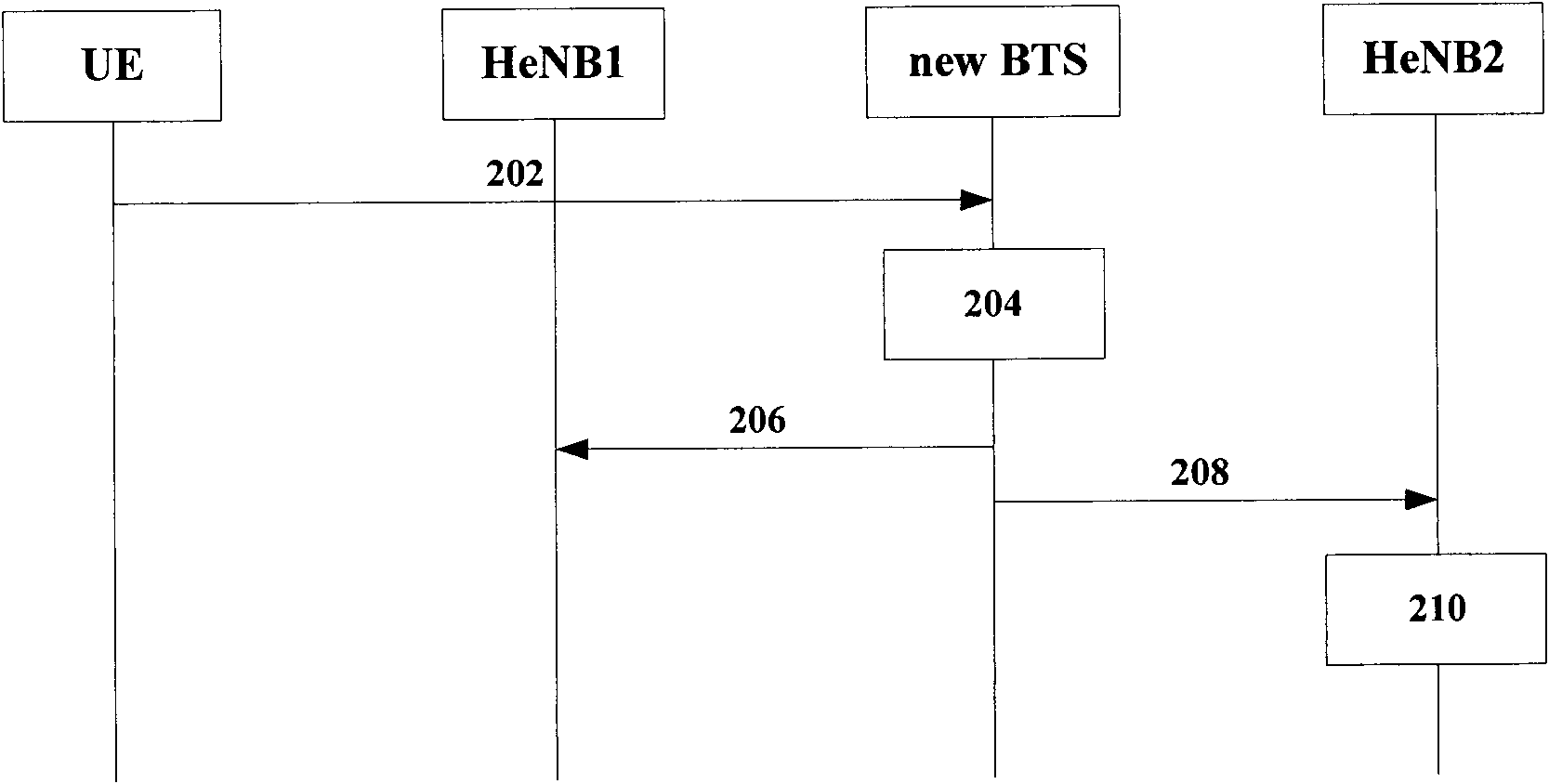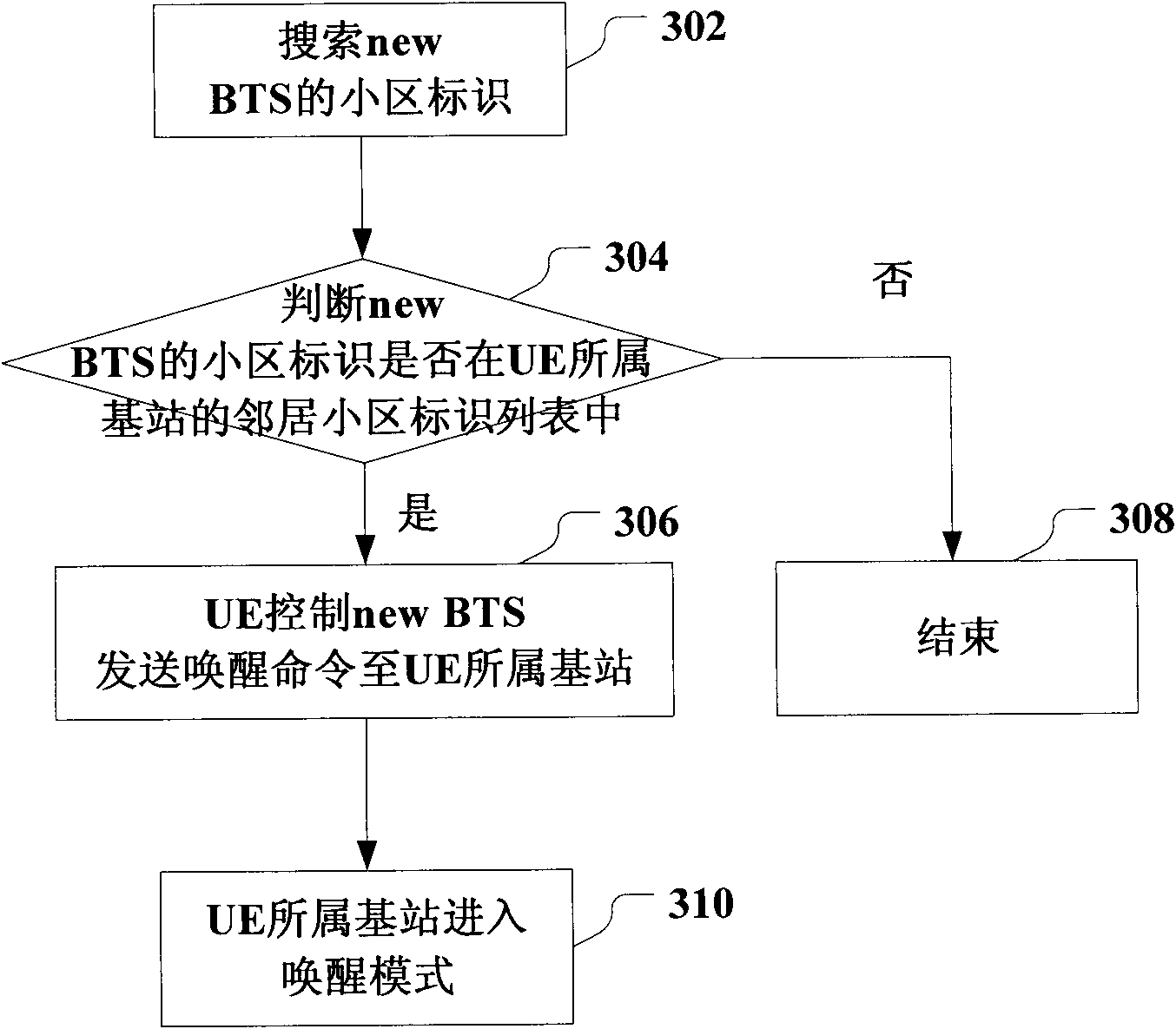Base station control method and system thereof, and apparatuses
A base station control and base station technology, applied in the field of network management, can solve the problems of HeNB energy waste and surrounding user interference, and achieve the effects of ensuring user experience, reducing energy consumption, and avoiding interference
- Summary
- Abstract
- Description
- Claims
- Application Information
AI Technical Summary
Problems solved by technology
Method used
Image
Examples
no. 2 example
[0066] Such as figure 1 As shown, the second embodiment of the base station control method of the present invention includes the following steps:
[0067] Step 102: When the UE leaves HeNB1 to the new base station new BTS, the new BTS sends a sleep command to HeNB1;
[0068] Step 104: After the HeNB1 receives the sleep command, it detects whether there is a serving UE within the first preset time period.
[0069] Step 106: When there is no serving UE, turn off its own radio frequency module, and HeNB1 enters sleep mode;
[0070] Step 108: When there is a serving UE, HeNB1 works normally.
[0071] In the second embodiment, the home base station determines whether to enter sleep mode by receiving sleep commands notified by other base stations and combining with the detection of its own business load, so that the home base station can turn off the radio frequency module in time and enter sleep mode when there is no business demand. Mode, thereby further reducing the energy consumption of ...
no. 3 example
[0072] Such as figure 2 As shown, the third embodiment of the base station control method of the present invention includes the following steps:
[0073] Step 202: When the UE performs a cell handover, the UE sends a first list CPlist containing cell identities of all its base stations to the new BTS, and the CPlist contains PCIs of all base stations of HeNB1;
[0074] Step 204: After the UE switches from HeNB 1 to the new BTS, the new BTS compares the second list Nlist and CPlist containing its own neighbor cells, and determines the intersection of the CPlist and Nlist except for the first base station. NCSGlist,
[0075] Mark [(CPlist∩Nlist)-HeNB1]=NCSGlist;
[0076] Step 206: The new BTS sends a sleep command to HeNB1, and HeNB1 judges according to step 104 in the second embodiment of the above method to determine whether to enter a sleep state;
[0077] Step 208: When NCSGlist≠0, new BTS sends a wake-up command to all base stations in NCSGlist. For example, HeNB2 is a home base st...
no. 4 example
[0083] Such as image 3 As shown, the fourth embodiment of the base station control method of the present invention includes the following steps:
[0084] Step 302: When the UE switches to the new BTS, it searches for the cell identity PCI of the new BTS;
[0085] Step 304: Determine whether the cell ID of the new BTS is in the neighbor cell ID list of the base station (HeNB1) to which the UE belongs, if yes, go to step 306; otherwise, go to step 308;
[0086] Step 306: The UE controls the new BTS to send a wake-up command to HeNB1;
[0087] Step 308, end;
[0088] Step 310: After the HeNB1 receives the wake-up command, it enters the wake-up mode.
[0089] Preferably, if the UE does not switch to the HeNB1 within the second preset time period, and there is no UE serving in the HeNB1, the HeNB1 enters the sleep state.
[0090] In addition, when the UE stays in the new BTS for more than the time period, the new BTS periodically sends a wake-up command to the HeNB1, or the HeNB1 controls its...
PUM
 Login to View More
Login to View More Abstract
Description
Claims
Application Information
 Login to View More
Login to View More - R&D
- Intellectual Property
- Life Sciences
- Materials
- Tech Scout
- Unparalleled Data Quality
- Higher Quality Content
- 60% Fewer Hallucinations
Browse by: Latest US Patents, China's latest patents, Technical Efficacy Thesaurus, Application Domain, Technology Topic, Popular Technical Reports.
© 2025 PatSnap. All rights reserved.Legal|Privacy policy|Modern Slavery Act Transparency Statement|Sitemap|About US| Contact US: help@patsnap.com



